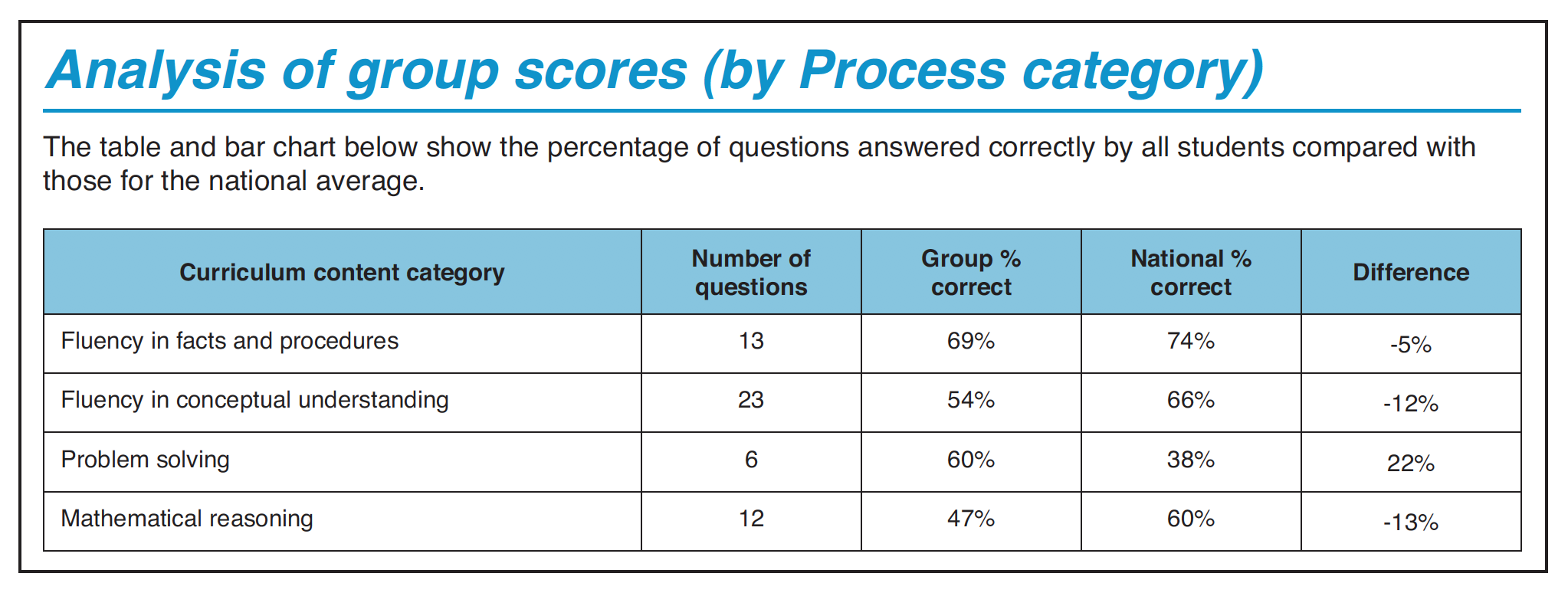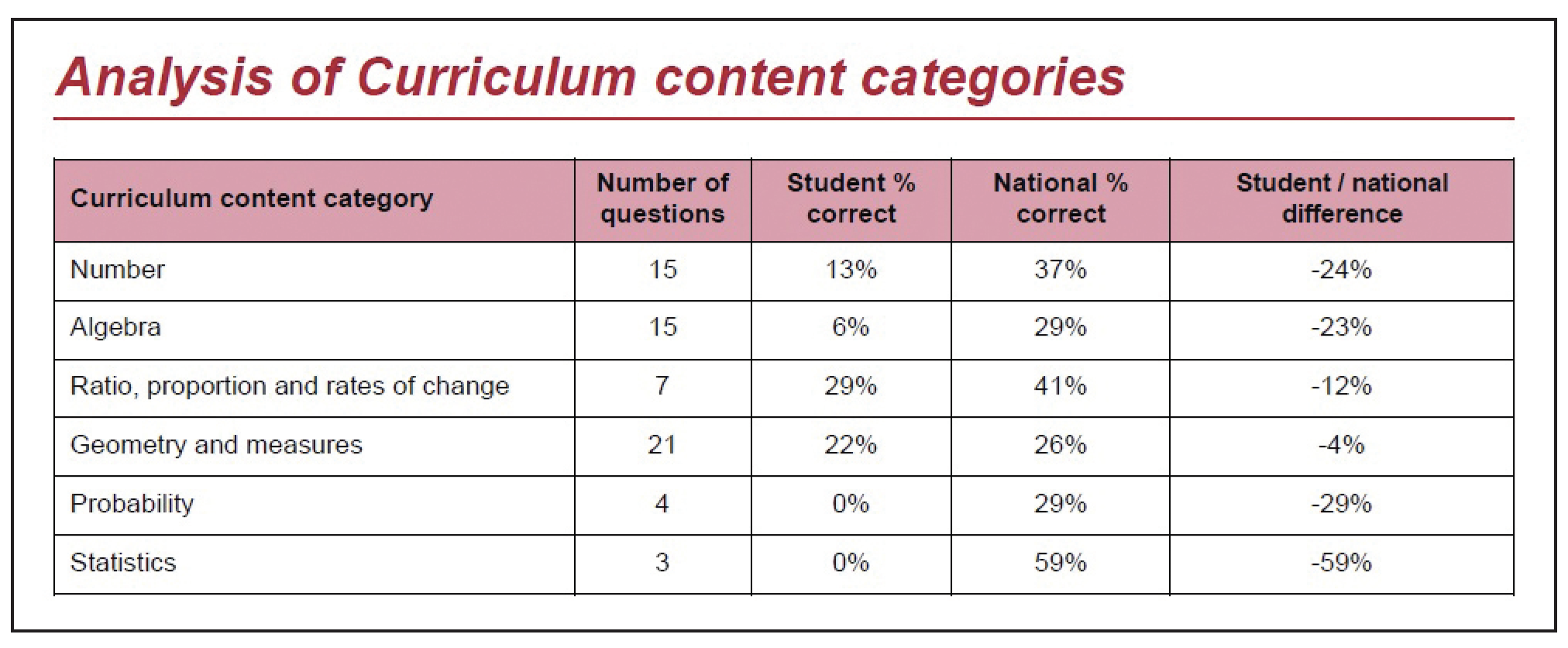Dimensions of mathematical competency
Both PTM and PISA have been developed from frameworks that identify the domain of mathematical competency as an area vital for success in life and in engaging with the world around us.
To measure these skills and knowledge, each item in both tests has different dimensions: a mathematical process category and a mathematical content category. PISA items also address the dimension of context. Test items in PTM have been developed with a view of being relevant to the real-life context of children in each age group, but this dimension is not separately assessed in the test, as focus is on mathematical understanding.
Both tests are based on the latest research and are measures of learning in mathematics, as well as the skills and knowledge expected from the age group being tested. Therefore, there is significant overlap in both the process and content categories of PISA and PTM. 4
4 For additional details on the process and content categories, please see PTM Links to National Curricula documents and report samples, and PISA 2015 Draft Mathematics Framework.
Process categories
Mathematical process categories describe working and thinking skills in mathematics beyond simple recall of facts and standard procedures. They relate to the use and application of mathematics.
PISA and PTM both address this in-depth learning and understanding, and assess several aspects important to mathematical competency. The language used to describe these processes varies, but the intentions are similar, as can be seen from the following table comparing PISA and PTM categories.
Mathematical process categories describe working and thinking skills in mathematics beyond simple recall of facts and standard procedures.
| Mathematical process categories in PISA 2012 and 20155 | Mathematical process categories in PTM |
|
|
|
|
|
|
Information about skills in these process categories is presented in PTM reports on individual and group levels, in comparison to averages in the age group, to help identify areas for further development. This allows teachers to set individual and group targets in these categories and monitor attainment. With this data they are able to provide support for all students according to their individual needs.

Sample PTM9 Group Report for Teachers
The number of items in each process category varies depending on the PTM test level, with more focus on problem solving and reasoning in the higher levels.
5 p.9–12, PISA 2015 Draft Mathematics Framework, 2013
Content categories
The content categories measure understanding and knowledge of mathematics. There are different ways of grouping mathematical content areas and different terms can be used to describe similar content. In basic education, mathematical terms are often replaced with terms from everyday language to make them more relatable to the experiences students have and contexts they are familiar with.
In PISA there are four content categories. These were identified in a study that looked at mathematical content taught in 11 countries to identify content that is forward-thinking, but also such that 15-yearold students were likely to have had an opportunity to learn it, and that is relevant to what is expected of them in further study and in the workplace. The previous mathematics curriculum for KS3 in England is one of the references cited in the PISA framework. The topics chosen for PISA “reflect commonalities found in the expectations set by a range of countries and educational jurisdictions.” (p.19–20, p.52, p.17, PISA 2015 Draft Mathematics Framework, 2013) The new English curriculum - which has been used to develop PTM - is more demanding than the previous one. Therefore, students whose performance has been measured with PTM and appropriate steps taken based on the results, are expected to be well prepared for the demands of PISA.
The division of items to content categories is important for reporting purposes and for gaining a deeper understanding of each individual’s learning against set targets. Where an item covers content from different categories the main content area is usually chosen when mapping items to categories.
The following table presents how the mathematical content categories in PISA relate to the six content categories used in PTM14 (number; algebra; ratio, proportion and rates of change; geometry and measures; probability; and statistics). Algebra falls under several, or all, of the PISA categories, depending on the test item. Some content topics may be addressed in more than one content category. (p.17, PISA 2015 Draft Mathematics Framework, 2013)
| Mathematical process categories in PISA 2012 and 20156 | Mathematical content categories in PTM14 |
| Change and relationships | Ratio, proportion and rates of change |
| Space and shape | Geometry and measures |
| Quantity | Number |
| Uncertainty and data | Probability, statistics |
Information about skills in the different content categories is presented in PTM reports on individual and group level, in comparison to averages in the age group, to help identify areas for further development. This allows teachers to set individual and group targets for the different areas and monitor attainment. They are then also able to provide support for all students according to their individual needs.

Sample PTM14 Individual Student Report for Teachers
The content categories differ for the age groups according to the skills expected from them, and the number of items in each category varies. This allows students to progress at age-appropriate pace and build a solid pathway to performing at age-expected level when they are 15 years old, which is when PISA is administered.
This allows students to progress at age-appropriate pace and build a solid pathway to performing at age-expected level ...
6 (p.17–19, PISA 2015 Draft Mathematics Framework, 2013)
Was this useful?
Our priority is to ensure you have the information you need to get the best from our products, and would like to know if this page helped you find what you needed?

